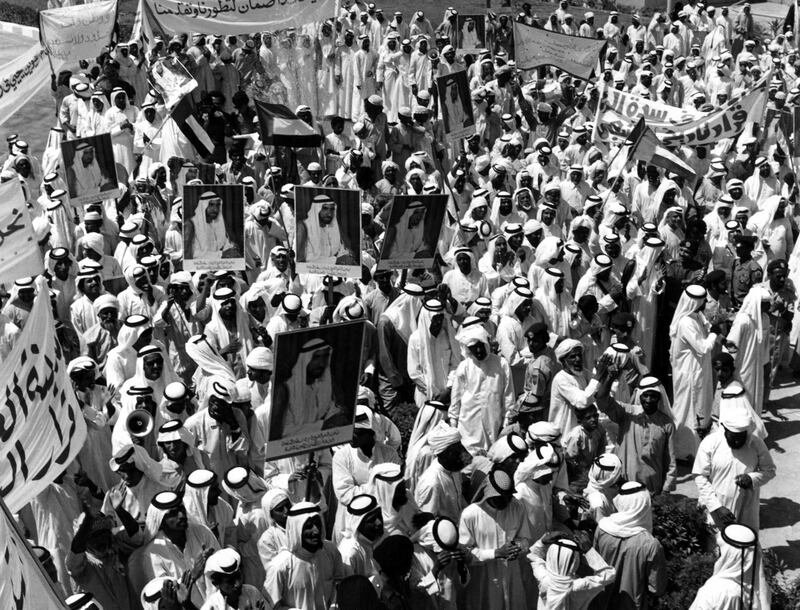At the start of 2018 this newspaper began a project to mark the Year of Zayed. A quote from or fact about the Founding Father has appeared on our social media channels every day since. With the project and the year now in its final third, what does that patchwork of pronouncements, commentary and historical moments tell us about his work?
The project has involved digging through speeches and working through history books. A wealth of texts reveal much about the duties undertaken by Sheikh Zayed from August 1966, when he became Ruler of Abu Dhabi, to his decades of service as President, which began in December 1971.
It is easy now to frame the story of the UAE’s rise to prominence as one in which destiny and successful development were always and absolutely guaranteed. That the story of this country’s rise fits so neatly into that particular narrative arc is, of course, testament to Sheikh Zayed’s vision and his brand of leadership.
Our social media posts throughout this year have offered a taste of his many qualities. They have also provided insights on his abilities as a statesman and a politician, and given a flavour of his nation-building work. In one short quote, for instance, he clearly sets out his mission: “We are concerned to provide a better life for all citizens throughout the Federation.”
We are also able to develop a picture of how effective Sheikh Zayed was as a leader in the international community and, particularly, in regional affairs. The late Kofi Annan, for instance, praised his "wisdom, strong belief in diplomacy and generous assistance to developing nations".
Extraordinary as it may sound now, there were times when the journey appeared a lot tougher, and the ultimate destination – the safe, prosperous and secure nation we see today – may have seemed much further away. One such occasion was the summer of 1976.
The year 1976 was a marked by global disruption: in the UK, punk music was shattering the norms of Western society, and Concorde broke the sound barrier on its first commercial flight to Bahrain. In the United States, Jimmy Carter was elected the 39th president, unseating the unelected incumbent Gerald Ford, upon whom power had been thrust as a consequence of the Watergate scandal. The Apple Computer Company, meanwhile, was taking its first steps along the road to its present $1trillion valuation. And in the UAE, the year was marked by a political story of great consequence.
On August 1, 1976, Sheikh Zayed gave an interview to Bahrain's Akhbar Al Khaleej newspaper, in which it was reported that he did not wish to seek a second five-year term as President after the end of his first term later that year. After a few days, in response to comments that he may have been misquoted, the story was confirmed.
The news triggered a season of drama and dialogue.
Graeme H Wilson records this period in great detail in Zayed: Man Who Built a Nation, published in 2013 by the National Centre for Documentation and Research. He notes the "profound shock" of the country at this time. Official phones rang off the hook, a flurry of communiques were sent and received, and students began a vigil imploring Sheikh Zayed to change his mind. The people were unanimous: it was vital that Founding Father stay in office.
On September 9, almost six weeks after he had made his original statement, Sheikh Zayed flew back from a diplomatic trip. Wilson reports that “thousands of people began arriving along the presumptive route from Abu Dhabi International Airport to Al Bateen Palace”. The crowds made for a long journey home.
When the President eventually made it back to the palace, the gates were "thrown open", and members of the assembled throng were offered refreshment and shade as he made his way through, talking to many of them individually. Within 24 hours, Sheikh Zayed had, according to The Chronicle of Progress, "sent a letter of thanks to the people of the Emirates for their historic stand and for all their love and appreciation".
Taken together, the crowds that gathered on that hot and humid September day to implore their leader to continue his good work, and the gratitude he expressed in return represented the first signs that the situation could be brought back from the brink.
The narrative continued on two separate but parallel tracks for several weeks after that significant afternoon: rulers, leaders and politicians maintained their dialogue with Sheikh Zayed, while the general public repeatedly flooded the streets in peaceful shows of support for him. There is something unique in the quiet and orderly dignity of those moments, and the entire episode speaks volumes about the empathy that flowed between the country’s leadership and its citizens.
Most of those familiar with the UAE are aware that Sheikh Zayed carried on his work as President until 2004. Many will not know that history could easily have taken a different turn.
The Year of Zayed is a celebration of the Founding Father’s life and legacy. As two key dates on the nation’s calendar approach – Commemoration Day and National Day in November and December – it is worth reflecting once more on his work and the perfect time for us all to develop a deeper understanding of the journey the UAE has taken since its foundation on December 2, 1971.
Nick March is an assistant editor-in-chief at The National





